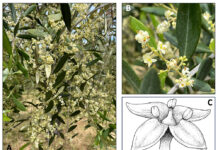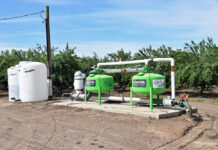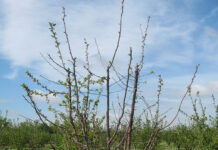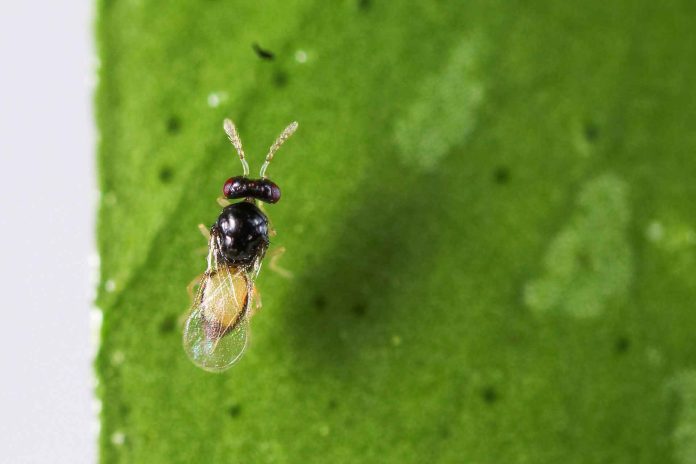All photos courtesy of Citrus Disease and Pest Prevention Program
Last summer’s long hot spell may have contributed to the low trap counts of Asian Citrus Psyllid (ACP) in the Central Valley, but researchers remain adamant that keeping the numbers low is the best defense the state’s citrus belt has to keep out Huanglongbing (HLB).
Meanwhile, detection of HLB infected trees in residential areas of the southern California counties of Orange, Los Angeles and San Bernardino, continues to expand.
At the Kern County Spring Citrus meeting, Dr. Beth Grafton-Cardwell, director of the University of California (UC) Lindcove Research and Extension, said the threat to commercial citrus is real.
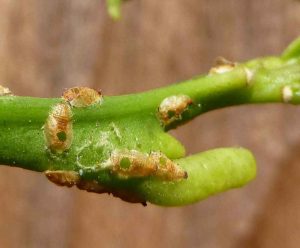
Best Techniques for Reducing Spread of ACP
Newly hatched ACP nymphs feeding on an infected tree quickly pick up the bacterium that causes the disease, and move on to infect other citrus trees. Removal of infected trees can help slow the spread, but detecting an HLB-infected tree can take time. Grafton-Cardwell said trees may initially only be infected on one quadrant and can be missed in a survey. It may take a year or two before the entire tree is infected, diagnosed and removed.
Coordinated spray treatments by growers when warranted by trap finds, treating with insecticides that have an extended residual and being vigilant about cultural practices are the important steps in keeping the state’s citrus industry viable in the face of HLB.
Movement of stem and leaf material, whether by harvest crews, hedging and topping equipment or on spray rigs can help prevent ACP from hitchhiking to new territory.

Although ACP finds in the San Joaquin Valley have been spotty, Grafton-Cardwell said the coordinated treatments are a tremendous tool.
“We are still in the eradicative mode here,” she stressed.
Besides the San Joaquin Valley, growers in the desert and Coachella areas have also been keeping the lid on ACP populations with coordinated treatments. The Ventura coastal growing region and Riverside-San Bernardino citrus have more ACP pressure. A summary of 224 scouted sites in California from June 2017 to September 2018 showed that at Ventura’s 47 sites, 87 percent had ACP nymphs present. In the Riverside San Bernardino region of the 47 sites, 88 percent were infested. The 50 sites in the San Joaquin Valley had zero percent while Coachella’s 45 sites had 8 percent.
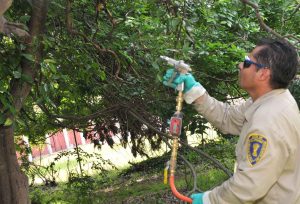
Samples
The hot, dry weather in the desert and San Joaquin Valley growing areas help harden new flush depriving ACP as they need soft flush to lay eggs and as food for the nymphs. Growers or farm managers are asked to sample for ACP whenever young flush is present. The protocol is to sample one flush on ten trees on each border of a block. If ACP is found, the grower liaison should be notified to confirm a find and make plans for a coordinated treatment. Grafton-Cardwell said not to rely on empty yellow sticky traps to make determine if ACP has invaded an orchard, as they prefer the new flush.
Workshops on sampling for ACP will be held again this year, Grafton-Cardwell said.
When growers are asked to participate in a coordinated treatment they should respond quickly and use the most effective product possible. These treatments are another reason why ACP levels have been lower in the San Joaquin Valley, plus growers are also using pyrethroids to control glassy winged sharpshooter.
It is important to note that ACP tend to be found on the border trees of the blocks. For all insecticide applications, the borders should be treated before treating the interior. Research has shown, Grafton-Cardwell said, that 80 percent of the ACP in a block are on the border trees. This does not hold true for young citrus.
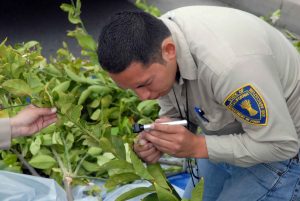
Residual Toxicity
In addition to the coordinated treatments, the residual toxicity of the pesticide used is important. Broad spectrum products that have a four plus week residual include Baythroid, Danitol, Actara, Admire, Leverage and Agri-flex. These products come with a warning that use may cause flare ups of scale or mites. Insecticides that are selective with a two to four week residual are Delegate, Exirel, fujimite, Movento and Surround. Materials allowed in organic production have a residual of less than two weeks. They include Pyganic, Entrust, oils and Celite. These need to make direct contact to be effective and Grafton-Cardwell recommends two spray applications to increase chances of control.
The longer the residual, the more effective the product will be in controlling ACP as eggs and nymphs are difficult to reach with a spray and adult ACP can fly in from untreated areas and not be affected. The goal is to keep ACP nymphs below 0.5 per flush. Admire and Platinum gave the best results.

Biological Control
Biological control, release of the parasite Tamarixia by California Department of Food and Agriculture (CDFA) throughout ACP infested residential sites in southern California, will continue, Grafton-Cardwell said. Releases in commercial citrus are not feasible due to use of spray applications for other insect pests and timing.
Tamarixia populations build and move into citrus October-November, after fall flush.
Control measures buy time for research and horticultural advances including early detection, using genetic engineering to create a protected tree, and HLB resistance. Other strategies include higher density orchards planned for shorter tree life span, using interference RNAs to prevent ACP from picking up the disease and growing citrus under protective cover.
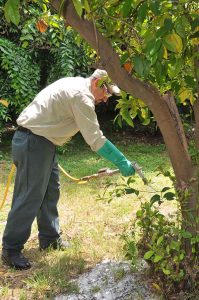
Pest Control Districts
Judy Zaninovich, Kern County ACP/HLB grower liaison said residential finds of ACP were very high 2015-16. The county pest control district’s pilot program for residential citrus has taken out 2,000 trees near sites where ACP was detected. There are similar pilot programs in southern California counties.
In southern California a total of 1,127 HLB positive trees have been removed. Last year at this time the number was 501 trees. This shows the disease is spreading, but also that CDFA is improving their detection.
Last year, Zaninovich said, the potential for a late summer spike in ACP populations was recognized and coordinated treatments were done. Knowing there is the potential for an upswing in ACP at that time, she said the plan would be repeated this year. She said there is also evidence that nighttime applications may be more effective.
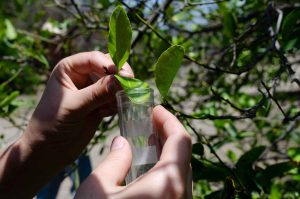
Irrigation Injection
Best practices for application of systemic pesticide imidacloprid delivered via irrigation was discussed by both Sarge Green, director of Center for Irrigation Technology at Fresno State and Rick Leonard of Bayer.
Distribution optimization is the key. The goal there is to make sure the water is in the right place at the right time. Green said the soil type controls movement of the material and pore size dictates movement. Matching water delivery to the soil type will improve efficacy of the material applied. Green noted that regular maintenance and auditing of the water delivery system is important in micro and drip systems.
Leonard supplied some of the basics for efficient use of imidacloprid delivered via irrigation. Admire systemic can be tank mixed with fertilizer, but needs agitation. In a 12 hour set, the product should be injected in a one to two hours period after the first three to four hours of the set to achieve the best distribution.
It will take two to three weeks for the material to move up from the roots into the trees. The cooler the weather during that time, the longer it will take to move throughout the tree. The best strategy of use is to target the fall flush.
Ventura coastal area growers have a more difficult time achieving success with this systemic application, Leonard said, due to the high clay and organic matter soils. If the material only reaches the sub lethal levels for ACP, it invites resistance.


